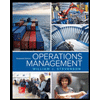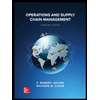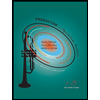e) Solve the mixed-integer linear program formulated in part (d). How much of each product should be produced and what is the projected total profit contribution? Compare this profit contribution to that obtained in part (c). If required, round your answers to nearest whole number. If your answer is zero enter "0". Product 1 Product 2 Product 3 00 Amount to Produce Updated Profit
e) Solve the mixed-integer linear program formulated in part (d). How much of each product should be produced and what is the projected total profit contribution? Compare this profit contribution to that obtained in part (c). If required, round your answers to nearest whole number. If your answer is zero enter "0". Product 1 Product 2 Product 3 00 Amount to Produce Updated Profit
Practical Management Science
6th Edition
ISBN:9781337406659
Author:WINSTON, Wayne L.
Publisher:WINSTON, Wayne L.
Chapter2: Introduction To Spreadsheet Modeling
Section: Chapter Questions
Problem 20P: Julie James is opening a lemonade stand. She believes the fixed cost per week of running the stand...
Related questions
Question
100%
Please help in solving Part (e)
![**Hart Manufacturing Product Optimization**
Hart Manufacturing produces three products, each requiring specific operations in three departments: A, B, and C. Below are details for labor-hour requirements per department and profit contributions per product.
**Department Labor-Hour Requirements (per unit):**
| Department | Product 1 | Product 2 | Product 3 |
|------------|-----------|-----------|-----------|
| A | 1.50 | 3.00 | 2.50 |
| B | 2.00 | 1.50 | 2.00 |
| C | 0.25 | 0.25 | 0.25 |
During the next production period, available labor-hours are: 450 in Department A, 350 in Department B, and 50 in Department C. The profit contributions are: $25 per unit for Product 1, $28 for Product 2, and $30 for Product 3.
**(a) Linear Programming Model for Profit Maximization**
Objective: Maximize profit \( Z = 25P_1 + 28P_2 + 30P_3 \)
Subject to:
\[
\begin{align*}
1.5P_1 + 3P_2 + 2.5P_3 & \leq 450 \quad \text{(Dept A constraint)} \\
2P_1 + 1.5P_2 + 2P_3 & \leq 350 \quad \text{(Dept B constraint)} \\
0.25P_1 + 0.25P_2 + 0.25P_3 & \leq 50 \quad \text{(Dept C constraint)} \\
P_1, P_2, P_3 & \geq 0 \quad \text{and integer}
\end{align*}
\]
**(b) Solution to Linear Program**
Production recommendation:
| Product | Amount to Produce |
|-------------|-------------------|
| Product 1 | 60 |
| Product 2 | 80 |
| Product 3 | 60 |
Total Profit: \$5540
**(c) Production Setup Costs**
Setup costs: $550 for Product 1, $400 for Product 2, $600 for Product 3.
Revised Total Profit after setup](/v2/_next/image?url=https%3A%2F%2Fcontent.bartleby.com%2Fqna-images%2Fquestion%2Fb894e8fe-1c5c-40b2-9b0c-b397d4783847%2F5585ad18-45cb-45da-92ad-8b2c6c72d17b%2F1w9cwi_processed.png&w=3840&q=75)
Transcribed Image Text:**Hart Manufacturing Product Optimization**
Hart Manufacturing produces three products, each requiring specific operations in three departments: A, B, and C. Below are details for labor-hour requirements per department and profit contributions per product.
**Department Labor-Hour Requirements (per unit):**
| Department | Product 1 | Product 2 | Product 3 |
|------------|-----------|-----------|-----------|
| A | 1.50 | 3.00 | 2.50 |
| B | 2.00 | 1.50 | 2.00 |
| C | 0.25 | 0.25 | 0.25 |
During the next production period, available labor-hours are: 450 in Department A, 350 in Department B, and 50 in Department C. The profit contributions are: $25 per unit for Product 1, $28 for Product 2, and $30 for Product 3.
**(a) Linear Programming Model for Profit Maximization**
Objective: Maximize profit \( Z = 25P_1 + 28P_2 + 30P_3 \)
Subject to:
\[
\begin{align*}
1.5P_1 + 3P_2 + 2.5P_3 & \leq 450 \quad \text{(Dept A constraint)} \\
2P_1 + 1.5P_2 + 2P_3 & \leq 350 \quad \text{(Dept B constraint)} \\
0.25P_1 + 0.25P_2 + 0.25P_3 & \leq 50 \quad \text{(Dept C constraint)} \\
P_1, P_2, P_3 & \geq 0 \quad \text{and integer}
\end{align*}
\]
**(b) Solution to Linear Program**
Production recommendation:
| Product | Amount to Produce |
|-------------|-------------------|
| Product 1 | 60 |
| Product 2 | 80 |
| Product 3 | 60 |
Total Profit: \$5540
**(c) Production Setup Costs**
Setup costs: $550 for Product 1, $400 for Product 2, $600 for Product 3.
Revised Total Profit after setup
Expert Solution
This question has been solved!
Explore an expertly crafted, step-by-step solution for a thorough understanding of key concepts.
This is a popular solution!
Trending now
This is a popular solution!
Step by step
Solved in 4 steps with 3 images

Recommended textbooks for you

Practical Management Science
Operations Management
ISBN:
9781337406659
Author:
WINSTON, Wayne L.
Publisher:
Cengage,

Operations Management
Operations Management
ISBN:
9781259667473
Author:
William J Stevenson
Publisher:
McGraw-Hill Education

Operations and Supply Chain Management (Mcgraw-hi…
Operations Management
ISBN:
9781259666100
Author:
F. Robert Jacobs, Richard B Chase
Publisher:
McGraw-Hill Education

Practical Management Science
Operations Management
ISBN:
9781337406659
Author:
WINSTON, Wayne L.
Publisher:
Cengage,

Operations Management
Operations Management
ISBN:
9781259667473
Author:
William J Stevenson
Publisher:
McGraw-Hill Education

Operations and Supply Chain Management (Mcgraw-hi…
Operations Management
ISBN:
9781259666100
Author:
F. Robert Jacobs, Richard B Chase
Publisher:
McGraw-Hill Education


Purchasing and Supply Chain Management
Operations Management
ISBN:
9781285869681
Author:
Robert M. Monczka, Robert B. Handfield, Larry C. Giunipero, James L. Patterson
Publisher:
Cengage Learning

Production and Operations Analysis, Seventh Editi…
Operations Management
ISBN:
9781478623069
Author:
Steven Nahmias, Tava Lennon Olsen
Publisher:
Waveland Press, Inc.